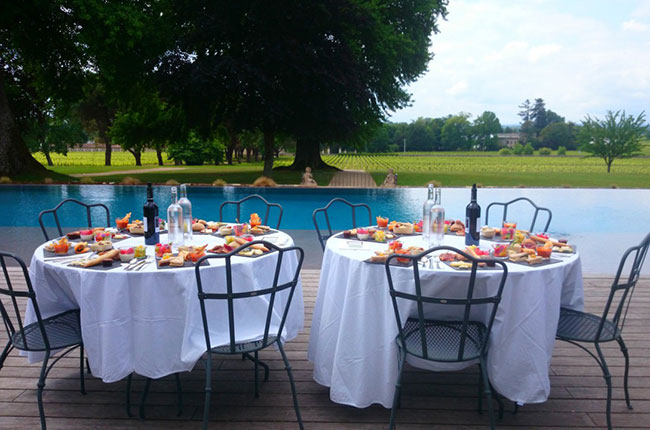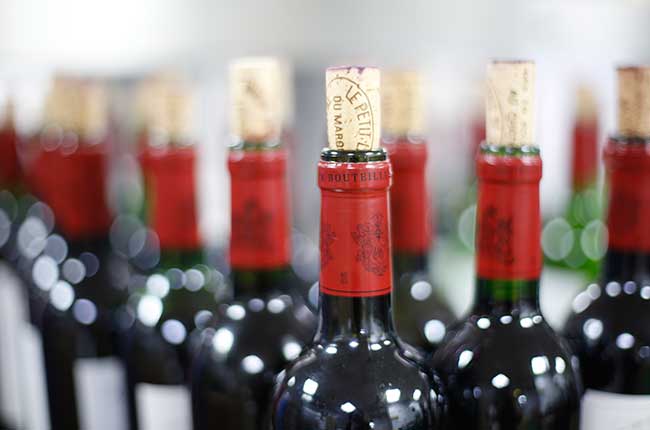It's not all about tracing your lineage to the 14th Century. Jane Anson picks out the most exciting of Bordeaux's newcomers...
I wrote a piece for Decanter last year on the spectator sport of tracking new winery openings in Napa.
Keeping up is pretty much a full-time job. From 2010 to 2014 alone, there were over 50 new wineries registering with the Napa Valley Vintners (NVV), from owners as diverse as NBA star Yao Ming to French billionaire François Pinault. A further dozen or so arrived during 2015 and 2016, and around 30 entirely new winery projects were approved by Napa County for planning permission (although some of these would be existing companies expanding or altering their facilities).
You could take an entirely more leisurely approach here in Bordeaux – less full-time job than a retirement hobby.
Scroll down to see Jane Anson’s new Bordeaux wineries to watch
Most wineries over on this side of the Atlantic take pride in announcing their centuries-old heritage rather than their recent genesis. And establishing yourself alongside the 8,000-or-so that already exist in this region is no mean feat, particularly when you are fighting against the Goliaths – look at the 1.5ha Domaine de la Passion Haut-Brion, which made its (re)start with the 2008 vintage under Michel Allary but had closed its doors again in 2012, calmly absorbed into its powerful neighbour Château Haut-Brion.
Another fledging property that didn’t make is Montagne St-Emilion’s Château Acapella, that was created back in 2001 by husband and wife Béatrice and Christophe Choisy and sold up two years ago – again incorporated into a bigger estate.
See also
I followed these guys from their early years, and was really sorry to learn that is no longer in production, but as Béatrice Choisy told me when I tracked her down, ‘having less than three hectares in Montagne St-Emilion was just too small to make financially viable’.
They did all the right things – picked good terroir, farmed organically using Burgundian methods such as open cask ferments, found a big name consultant in the form of Michel Rolland – but came up against the ‘price ceiling of the smaller appellations’ as they put it (and just this week the Chamber of Agriculture released a study setting the cost of organic production at around 15% higher than traditional viticulture).
She is now working back at her family property Château Perron of 23ha in Lalande de Pomerol, where economies of scale make things a little easier.
‘It wasn’t an easy decision to sell,’ she says, ‘but we learnt that enthusiasm only takes you so far in the face of the realism of cash flow. But I have no regrets – it was part of the experiences of youth’.
Bordeaux does have some new faces that have made it through the crucial first five years though and joined older startup successes that are now part of the landscape, such as Château Valandraud and Domaine de L’A, both created in the 1990s. Others are just starting out.
Fresh off the boat…
Château Clos de Boüard, Montagne St-Emilion
Coralie de Boüard and her husband Loïc Maillet have just unveiled the first vintage of this estate with their 2016 wine – although officially it is simply a rechristening of an older property called Château Tour Musset that was formerly owned by Castel Frères.
De Boüard of course has the family connections to open doors, as the daughter of Hubert de Boüard (who is working as consultant), and has 30 hectares of vines which allows the economies of scale that Acapella found so tough, but launching a new château brand is never easy.
This has great terroir though, with clay-limestone slopes located close to Châteaux Valandraud, Rocheyron and Troplong Mondot, and is planted to around 60/40 Merlot and the two Cabernets.
‘I’ve been looking for my own property for seven years,’ de Boüard told me this week, ‘and on the same day I bought this I looked at a property in St-Emilion itself which was more expensive but where the terroir just wasn’t good enough. I was only looking to buy 6 or 7 hectares, but the quality of the soils and their exposition here meant I couldn’t walk away. We are just over the Barbanne river that is the limit for AOC St-Emilion, but the quality potential makes it by far the better buy for me’.
Château la Séraphine, Pomerol
Englishman Martin Krajewski purchased 2.23 hectares of vines in Pomerol after selling Château de Sours to Jack Ma in late 2016, and promptly rechristened them Château Séraphine, after his Polish grandmother Seraphina (a popular naming device in Bordeaux it seems, as Château Belair-Monange in St-Emilion is also named after a grandmother – Edouard Moueix’s in this case).
Krajewksi bought 100% Merlot vines ranging from 10 to 55 years old, alongside (in a separate purchase) a plot of land with an old house and winery on it, which was formerly a tiny family estate looking out on the Pomerol village church.
He has since replanted half the vines, adding in some Cabernet Franc, is will have finished construction of a new winery building and château by the 2017 harvest, with wine tourism facilities planned for 2018. First vintage, he expects, in 2017, ‘although we are happy to be patient. Right now we are getting to know the terroir, making decisions on vineyard density and plantings, and working on the winery.
It’s an amazing opportunity to have bought something that we can shape and rebuild over the long term in an appellation like Pomerol, that is sprinkled with magic’.
Clos Sanctus Perfectus, St-Estèphe
Bernard Magrez has made his strategy clear over recent years – dispose of his lesser-quality estates and concentrate on the classified properties of Pape Clement, Fombrauge, La Tour Carnet at Clos Haut Pereguay.
He made an exception for this small patch of vines up in Saint-Estèphe bought in December 2016 that is due to produce somewhere around 3,000 bottles per year. Formerly a cru artisan property that they have renamed, director Frederic Chabanneau says the first vintage will be 2017 in a newly-equipped cellar.
‘The estate has four extremely high quality plots of deep gravel terroir on one of the highest points of the appellation,’ says Chabanneau. A good time to be buying in Saint Estèphe I would suggest, as the appellation has seen several strong vintages and is enjoying something of a boom.
Perhaps why land agency SAFER recorded a price rise per hectare of 9% between 2015 and 2016, up to an average of €380,000 per hectare.
A few years under their belt…
Château Fayat, Pomerol
Origin story here is that industrialist Clement Fayat bought three separate Pomerol estates over a number of years (the 10ha Commanderie de Mazeyres, and two 3ha Châteaux Vieux Bourgneuf, and Prieurs de la Commanderie), then in 2009 merged them all together and created a new entity called Château Fayat.
‘By refocusing, we were able to have the size to ensure better distribution,’ then-director Yannick Evenou told me at the time, pointing out at 16ha takes Château Fayat into the, who was responsible for the re-structuring. Today, the 16 hectare size parachutes Château Fayat into the top 10 in terms of the appellation.
L’Aura de Cambon, Margaux
This tiny half-hectare plot was sold in 2003 by the local village butcher, a man who for years had supplied the best cuts of meat to the illustrious Margaux properties that surrounded his shop but who decided to sell his land to a family rather than a big name that would have swallowed it up.
It was woodland at the time, with plantation rights, and Jean-Pierre Marie of cru bourgeois Château Cambon La Pelouse was the lucky recipient – buying it for a fraction of the cost than if it had already planted with vines. The first vintage was 2006.
Girolate Bordeaux
A wine that has been uncompromisingly ambitious since its launch in 2001. Made by the Despagne family in the lowly Bordeaux appellation, it began life as a 100% Merlot (some Cabernet Franc should be coming in over the next few years) grown at 10,000 vines per hectare on high quality clay-limestone slopes, barrel-fermented and aged in new oak, with Michel Rolland as consultant.
Always a dramatic wine, in recent years it has softened just the right amount, helped perhaps by bringing in biodynamic farming since 2010, with Demeter-certification expected in 2018.
‘The idea has always been to showcase the best terroirs of Entre deux Mers,’ Basaline Granger-Despagne told me during the primeurs tasting of the excellent 2016.
‘It’s still not always easy for people to look beyond the name Bordeaux on a label, but we feel Girolate is getting to the quality level that we always knew it could.’
A few others…
Domaine les Sadons, Pauillac
Until 1997 the patch of land that is now Alain Albistur’s vines was a vegetable garden. He was able use planting rights from his brother-in-law, only able to take over himself in 2006.
Château Lagneaux à Pauillac
Created in 2010 by Lagneaux family of Château Petit Bocq.
L’If, St-Emilion
Bought in 2010 by Jacques Thienpont, name change from Haut-Plantey with new plots also.
Quintus, St-Emilion
Prince Robert of Luxembourg of Haut-Brion created Quintus through the purchase of two classified properties, L’Arrosée and Tertre Daugay and combining them. In doing so, he lost their classified status (local St-Emilion rules being different from those in the Médoc or Pessac Léognan) and will have to reapply next time around – although I am told they are not decided if they will do so.
Château La Connivence, Pomerol
Less than 1ha for this estate owned by Alexandre de Malet Roquefort (of Château La Gaffelière in St-Emilion) with partners, first vintage 2009.
Château Haut Bacalan, Pessac Léognon
The Gonet Champagne family, led by Frédéric and Charles-Henri, bought this estate in 1998, and began replanting vines on ground that had been without them for nearly seven decades. The first harvest was 2001.
More articles like this:

Bordeaux châteaux restaurants to visit
Where to eat in the Bordeaux vineyards...

Anson: Guide to the new wave of Bordeaux châteaux restaurants
Why Bordeaux wine tourists are now spoilt for choice...

Anson: Best Bordeaux restaurant wine lists
Jane Anson names exciting sommeliers in the city...

Top Bordeaux 2016 wines in bottle: Full Médoc report
How the Médoc 2016 vintage tastes 18 months after en primeur...

Bordeaux 2016 Right Bank: Anson’s first impression
Read Jane Anson's early thoughts on the barrel samples...

Bordeaux 2016 in Médoc: Anson’s first impression
Read Jane Anson's early thoughts on the barrel samples...







